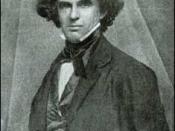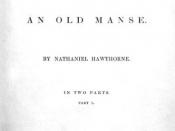The reasons that certain literary works become masterpieces, and are embraced and extolled, others receive encomium for a certain period of time and then fall into disfavor, and still others are seen as loathing and contemptible pieces of garbage are not always completely clear. However, Jane Tompkins cogently shows, through systematic example and analysis, that the decision is not an arbitrary one, nor is it a result of some endemic attribute, some divine quality that raises it to the pantheon of great literature, or of an inherently rebarbarative quality that rankles and nauseates. According to Tompkins, "a literary classic is a product of all those circumstances of which it has traditionally been supposed to be independent (137).
While many people believe socio-cultural, socio-political, and socio-economic forces have no power in shaping a work, or in reshaping it, Tompkins gives powerful evidence to disabuse them of their erroneous beliefs. Using the example of Nathaniel Hawthorne's rise to prominence, and his continued popularity generations and generations later, she shows that although the written words are identical, there has been tremendous mutability in the way that they were apperceived then and the way that they are viewed now.
In the 1830's, short stories such as "Sights from a Steeple" and "Little Annie's Ramble," were by far the most popular of his works, read and raved about by literature buffs everywhere. However, while Hawthorne is still immensely popular today among the academics, stories like the preceding ones have fallen by the wayside, giving way to such stories as "Young Goodman Brown" and "The Minister's Black Veil," which were only tangentially treated as laudable by his contemporaries. While such striking disparities may seem anomalous in the extreme, it becomes wildly pellucid once one considers one major factor: the societal interests, values, and needs of...



Good Boy, Tachycardic4u
I found this essay to be very interesting. You did nice work on this! I give you three thumbs up! Congrats. Well done!
5 out of 7 people found this comment useful.